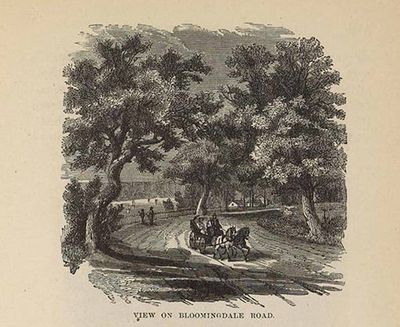Annotation:Bloomingdale Waltz: Difference between revisions
No edit summary |
Alan Snyder (talk | contribs) m (typo) |
||
| (One intermediate revision by one other user not shown) | |||
| Line 1: | Line 1: | ||
=='''Back to [[{{BASEPAGENAME}}]]'''== | =='''Back to [[{{BASEPAGENAME}}]]'''== | ||
---- | ---- | ||
<p><font face=" | <p><font face="sans-serif" size="4"> | ||
'''BLOOMINGDALE WALTZ'''. American, Waltz. A Major ('A' and 'B' parts) & D Major ('C' part). Standard tuning. AABBAACAA. "Bloomingdale Waltz" was composed and published in 1829 by New York musician Michael Higgins in his '''Original Dances, | '''BLOOMINGDALE WALTZ'''. American, Waltz. A Major ('A' and 'B' parts) & D Major ('C' part). Standard tuning. AABBAACAA. "Bloomingdale Waltz" was composed and published in 1829 by New York musician Michael Higgins in his '''Original Dances, Waltzes & Hornpipes for the Violin''' (1829, p. 10). The waltz was found in the music manuscripts of Long Island painter and fiddler William Sydney Mount (1807–1868). The title predates New York's famous Bloomingdale department stores, founded in 1861, but does refer to the district in New York City once known as Bloomingdale, the name given to the farms and houses along the Bloomingdale Road along Manhattan's Upper West Side. The name 'Bloomingdale' derivies from the Dutch name ''Bloemendaal'', Anglicized to "Bloomingdale" or "the Bloomingdale District." Bloomingdale Road's name was changed to The Boulevard in 1868, as the district gradually was absorbed into the city. [[File:bloomingdale.jpg|400px|thumb|left|]] | ||
<br> | <br> | ||
<br> | <br> | ||
</font></p> | </font></p> | ||
<p><font face=" | <p><font face="sans-serif" size="4"> | ||
''Source for notated version'': Gilbert Ross [Phillips]. | ''Source for notated version'': Gilbert Ross [Phillips]. | ||
<br> | <br> | ||
<br> | <br> | ||
</font></p> | </font></p> | ||
<p><font face=" | <p><font face="sans-serif" size="4"> | ||
''Printed sources'': Higgins ('''Original Dances, | ''Printed sources'': Higgins ('''Original Dances, Waltzes & Hornpipes for the Violin'''), 1829; p. 10. Phillips ('''Traditional American Fiddle Tunes, vol. 2'''), 1995; p. 242. | ||
<br> | <br> | ||
<br> | <br> | ||
</font></p> | </font></p> | ||
<p><font face=" | <p><font face="sans-serif" size="4"> | ||
''Recorded sources'': <font color=teal></font> | ''Recorded sources'': <font color=teal></font> | ||
</font></p> | </font></p> | ||
Latest revision as of 21:41, 17 March 2020
Back to Bloomingdale Waltz
BLOOMINGDALE WALTZ. American, Waltz. A Major ('A' and 'B' parts) & D Major ('C' part). Standard tuning. AABBAACAA. "Bloomingdale Waltz" was composed and published in 1829 by New York musician Michael Higgins in his Original Dances, Waltzes & Hornpipes for the Violin (1829, p. 10). The waltz was found in the music manuscripts of Long Island painter and fiddler William Sydney Mount (1807–1868). The title predates New York's famous Bloomingdale department stores, founded in 1861, but does refer to the district in New York City once known as Bloomingdale, the name given to the farms and houses along the Bloomingdale Road along Manhattan's Upper West Side. The name 'Bloomingdale' derivies from the Dutch name Bloemendaal, Anglicized to "Bloomingdale" or "the Bloomingdale District." Bloomingdale Road's name was changed to The Boulevard in 1868, as the district gradually was absorbed into the city.

Source for notated version: Gilbert Ross [Phillips].
Printed sources: Higgins (Original Dances, Waltzes & Hornpipes for the Violin), 1829; p. 10. Phillips (Traditional American Fiddle Tunes, vol. 2), 1995; p. 242.
Recorded sources:
